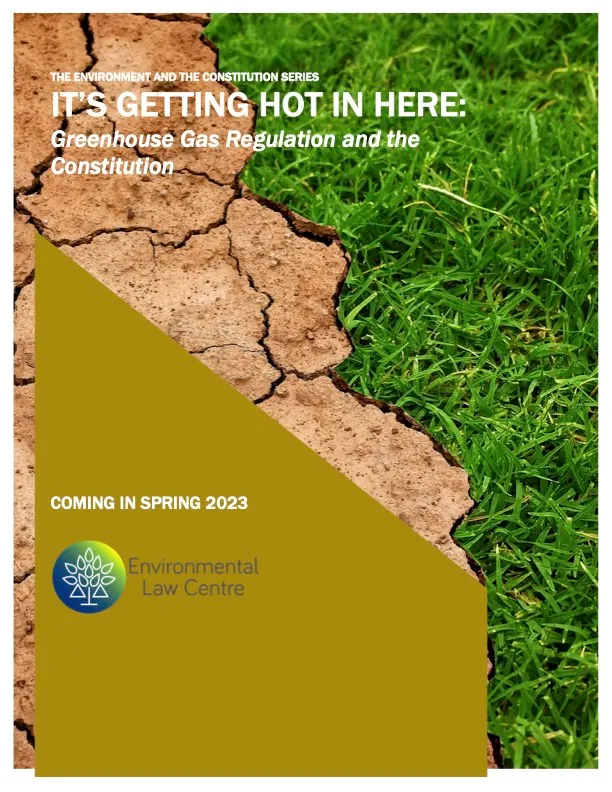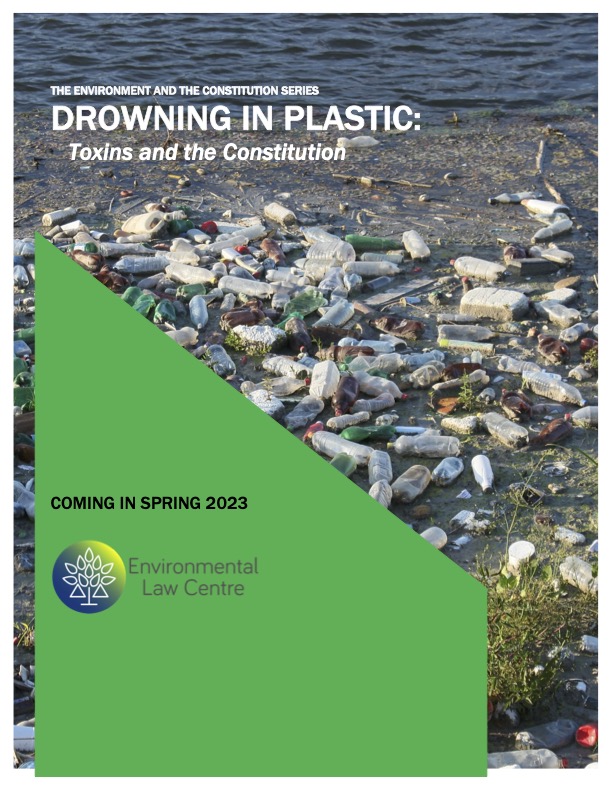The Environment & The Constitution Series:
GHGs and Toxic SubstancesAN ELC REPORT SERIES
The ELC is pleased to present a series of reports and webinars in relation to the constitutional challenges around environmental management. Underlying this series is the question of whether we can move past ongoing conflict, the battleground of the environment, and seek a more environmentally harmonious approach to management. The first step in answering this question is to understand our current legal state. We began with a backgrounder on Constitutional Law and the Environment and from there move on to topical reports.
The second set of topical reports consider the constitutional jurisdiction to manage greenhouse gas emissions and toxic substances including marine pollution, plastics, and hazardous goods management. They will also be the subject of an upcoming webinar.
It’s Getting Hot in Here: GHG Regulation and the Constitution

Greenhouse Gas (GHG) emissions are not included in the enumerated grounds of sections 91 or 92 of the Constitution Act, 1867 and, as such, neither the provincial nor the federal government are directly assigned the power to legislate GHGs. Generally, the provinces have jurisdiction over their natural resources through section 92A of the Constitution Act, 1867 and their broad jurisdiction to regulate local works and undertakings, public lands in the province, and property and civil rights.[1] In Alberta, the regulation of GHGs is done primarily through the Technology Innovation and Emissions Reduction Regulation.[2]
However, the regulation of greenhouse gas emissions is also done at the federal level. For example, the Greenhouse Gas Pollution Pricing Act and specifically “minimum national standards of GHG price stringency to reduce GHG emissions” were the subject of a recent Supreme Court of Canada (“SCC”) decision.[3] In this decision, the SCC found the Greenhouse Gas Pollution Pricing Act could be upheld under the federal peace, order, and good government power.[4] This was an important case because decisions made by the SCC are binding on courts across the country and this will impact on future decisions with regard to the management and regulation of GHGs. The federal government has also included certain GHG emissions under the List of Toxic Substances in the Canadian Environmental Protection Act and plans to enact further management of these emissions through the Canadian Net-Zero Emissions Accountability Act.
This report will consider the regulation of GHG emissions at both levels of government and discuss how this may extend to proposed legislation including a proposed federal cap on emissions.
Drowning in Plastic: Toxins and the Constitution

Despite the fact that the Constitution Act, 1867 does not refer specifically to toxic substances, there is clear jurisdiction for provincial governments to manage toxic substances through a variety of heads of power including local works and undertakings, all matters of a merely local or private nature, and the section 92A jurisdiction over the development of non-renewable natural resources, forestry, and electrical energy resources.[5]
In addition, often through caselaw, federal jurisdiction over toxic substances has also been situated in a variety of heads of power including the federal peace order and good government power, criminal law, navigation and shipping, and seacoast and inland fisheries powers.[6] Importantly, the specific head of power has differed depending on the type of pollution. For example, federal jurisdiction over the dumping of waste products in waters, other than fresh waters, within a province was situated within the POGG power in the Supreme Court of Canada decision of R v Crown Zellerbach, discussed below.[7] On the other hand, the regulation of toxic substances through the Canadian Environmental Protection Act, 1999 has been upheld under the criminal law power, as in R v Hydro-Quebec.[8] We begin this report with a discussion of some of the caselaw that has situated the federal law power in this regard and from there provide a summary of the existing regulatory framework at both levels of government.
Upcoming Webinar: March 21, 2023
Drowning in Plastic: Toxins and the Constitution; and
It’s Getting Hot in Here: GHG Regulation and the Constitution
Register in advance for this webinar:
After registering, you will receive a confirmation email containing information about joining the webinar.
View past webinar recordings
[1] Constitution Act, 1867 (UK), 30 & 32 Vict, c 3, reprinted in RSC 1985, App II, No 5, ss 92(5), (10) & (13).
[2] Technology Innovation and Emissions Reduction Regulation, Alta Reg 133/2019.
[3] Reference re Greenhouse Gas Pollution Pricing Act, 2021 SCC 11 at para 4.
[4] Constitution Act, 1867 (UK), 30 & 32 Vict, c 3, reprinted in RSC 1985, App II, No 5, s 91.
[5] Constitution Act, 1867 (UK), 30 & 31 Vict, c 3, reprinted in RSC 1985, App II, No 5, ss 92(10), (16) & 92A.
[6] Constitution Act, 1867 (UK), 30 & 31 Vict, c 3, reprinted in RSC 1985, App II, No 5, ss 91, 91(10), (12) & (27).
[7] R v Crown Zellerbach Canada Ltd., [1988] 1 SCR 401.
[8] R v Hydro-Quebec, [1997] 3 SCR 213.
ABOUT THE ENVIRONMENTAL LAW CENTRE:
The Environmental Law Centre (ELC) has been seeking strong and effective environmental laws since it was founded in 1982. The ELC is dedicated to providing credible, comprehensive and objective legal information regarding natural resources, energy and environmental law, policy and regulation in Alberta. The ELC’s mission is to advocate for laws that will sustain ecosystems and ensure a healthy environment and to engage citizens in the laws’ creation and enforcement. Our vision is a society where our laws secure an environment that sustains current and future generations and supports ecosystem health.
As a charity, the Environmental Law Centre depends on your financial support. Help us to continue to educate and champion for strong environmental laws, through tools such as our blog and all of our other resources, so that all Albertans can enjoy a healthy environment. Your support makes a difference.
Donate online today
